
KubeVault is a Git-Ops ready, production-grade solution for deploying and configuring HashiCorp Vault on Kubernetes.
We are excited to announce the release of KubeVault v2022.12.09. You can now take Backup & Restore your Vault cluster managed by KubeVault or even deployed with Vault Helm Charts using Stash.
Stash by AppsCode is a complete Kubernetes native disaster recovery solution for backup and restore your volumes and databases in Kubernetes on any public and private clouds.
Read more about Stash here
. Stash add-on for Vault
lets you take Backup snapshot & Restore it whenever required for a Vault cluster backed with Raft maintaining the SOP provided by Vault.
Upon deploying Vault managed by KubeVault, an AppBinding will be created, which contains the necessary information needed for Backup & Restore process.
So, if you’re deploying Vault using Helm Charts, you’ll need to create the AppBinding yourself accordingly.
An AppBinding is a Kubernetes CustomResourceDefinition(CRD) which points to an application using either its URL (usually for a non-Kubernetes resident service instance) or a Kubernetes service object (if self-hosted in a Kubernetes cluster), some optional parameters and a credential secret. To learn more about AppBinding and the problems it solves, please read this blog post: The case for AppBinding
.
Here’s a sample AppBinding yaml created by the KubeVault operator on VaultServer deployment:
apiVersion: appcatalog.appscode.com/v1alpha1
kind: AppBinding
metadata:
labels:
app.kubernetes.io/instance: vault
app.kubernetes.io/managed-by: kubevault.com
app.kubernetes.io/name: vaultservers.kubevault.com
name: vault
namespace: demo
ownerReferences:
- apiVersion: kubevault.com/v1alpha2
blockOwnerDeletion: true
controller: true
kind: VaultServer
name: vault
spec:
appRef:
apiGroup: kubevault.com
kind: VaultServer
name: vault
namespace: demo
clientConfig:
service:
name: vault
port: 8200
scheme: http
parameters:
apiVersion: config.kubevault.com/v1alpha1
backend: raft
backupTokenSecretRef:
name: vault-backup-token
kind: VaultServerConfiguration
kubernetes:
serviceAccountName: vault
tokenReviewerServiceAccountName: vault-k8s-token-reviewer
usePodServiceAccountForCSIDriver: true
path: kubernetes
stash:
addon:
backupTask:
name: vault-backup-1.10.3
params:
- name: keyPrefix
value: k8s.kubevault.com.demo.vault
restoreTask:
name: vault-restore-1.10.3
params:
- name: keyPrefix
value: k8s.kubevault.com.demo.vault
unsealer:
mode:
googleKmsGcs:
bucket: vault-testing-keys
credentialSecretRef:
name: gcp-cred
kmsCryptoKey: vault-testing-key
kmsKeyRing: vault-testing
kmsLocation: global
kmsProject: appscode-testing
secretShares: 5
secretThreshold: 3
vaultRole: vault-policy-controller
So, in simple terms, all the information regarding your Vault deployment must be passed through the AppBinding itself.
For example:
spec.appRefcontains the application information for which thisAppBindingis created. ForVault Helm Chartsdeployment, such field can be ignored.spec.parameters.backendindicates the type ofStorage BackendyourVaultdeployment is using.spec.parameters.unsealercontains the information about your unseal mode & secrets associated with it.
For, Vault Helm Charts deployment, you’ll also need to create a token that has the necessary permission to take the Backup snapshot & Restore it.
You’ll then need create a Secret with this token & provide its reference in the spec.parameters.backupTokenSecretRef.
A sample policy may look like this:
path "sys/storage/raft/snapshot" {
capabilities = ["read"]
}
path "sys/storage/raft/snapshot-force" {
capabilities = ["read"]
}
KubeVault takes care of all of these stuff itself, as it creates the AppBinding during the VaultServer deployment based on the provided configurations, making it hassle-free to manage your Vault life-cycle & do Day-2 operations like Backup & Restore.
The detailed commit by commit changelog can be found here .
We held a webinar on Vault
Backup&Restore, take a deep dive into the full webinar below:
What’s Next?
Please try the latest release and give us your valuable feedback.
- If you want to install KubeVault, please follow the installation instruction from here .
Support
To speak with us, please leave a message on our website .
To receive product announcements, follow us on Twitter .
If you have found a bug with KubeVault or want to request new features, please file an issue .









